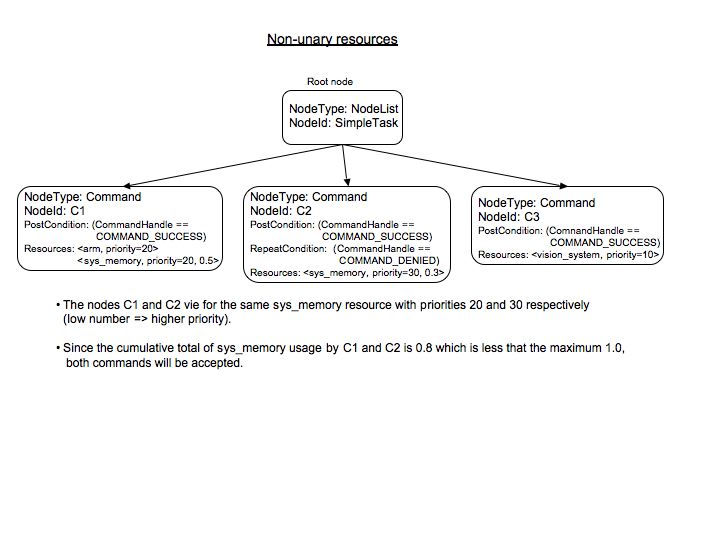Non-Unary Resources¶
26 Jan 2023
This example, which can be found in
plexil/examples/resources/resource2.ple, differs from the unary
resource example in that sys_memory is allocated in fractional
amounts, rather than as a whole. This is indicated by the keyword
UpperBound in the resource usage specification. (If
UpperBound is not supplied, the requested amount defaults to 1.0.)
In this example,
Node
C1commandc1requiresarmand 0.5 ofsys_memoryat priority 20Node
C2commandc2requires 0.3 ofsys_memoryat priority 30Node
C3commandc3requiresvision_systemat priority 10
The file plexil/examples/resources/resource2.data specifies that
1.0 units of each resource are available.
%Contains the resource hierarchy
% name initial-resource [child-weight child-name]*
arm 1.0
sys_memory 1.0
vision_system 1.0
As in the previous example, all 3 nodes and their respective commands are eligible to execute concurrently.
The resulting outcome will be to accept all the commands since the
cumulative memory requirements of C1 and C2 is less than 1.0.

The PLEXIL plan is shown below:
Integer Command c1;
Integer Command c2;
Integer Command c3;
SimpleTask:
Concurrence
{
C1: {
Integer returnValue = -1;
EndCondition returnValue == 10;
PostCondition C1.command_handle == COMMAND_SUCCESS;
Resource Name = "sys_memory",
UpperBound = 0.5,
Priority = 20;
Resource Name = "arm",
Priority = 20;
returnValue = c1();
}
C2: {
Integer mem_priority = 30;
Integer returnValue = -1;
RepeatCondition C2.command_handle == COMMAND_DENIED;
PostCondition C2.command_handle == COMMAND_SUCCESS;
EndCondition returnValue == 10;
Resource Name = "sys_memory",
UpperBound = 0.3,
Priority = mem_priority;
returnValue = c2();
}
C3: {
Integer returnValue = -1;
Integer vision_priority = 10;
PostCondition C3.command_handle == COMMAND_SUCCESS;
EndCondition returnValue == 10;
Resource Name = "vision_system",
Priority = vision_priority;
returnValue = c3();
}
}